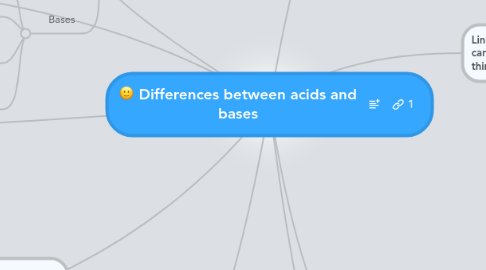Differences between acids and bases
by Sneha Sanil Parammal

1. Properties
1.1. Acids
1.1.1. React with most metals to form hydrogen gas
1.1.2. Taste sour (like lemons)
1.1.3. Frequently feel "sticky"
1.1.4. Usually gases or liquids
1.2. Bases
1.2.1. Feels "slippery". The slippery feeling is caused when your skin dissolves a little when you touch them.
1.2.2. Taste bitter (like baking soda)
1.2.3. React with oils and greases (that's why they're used as drain and window cleaners)
1.2.4. Frequently solids ( though ammonia is a gas that's usually dissolved in water)
2. Acids, alkalis and neutralisation - higher When atoms or groups of atoms lose or gain electrons, charged particles called ions are formed. Ions can be either positively or negatively charged. For the Higher Tier, you need to know which ions are produced by acids, and which are produced by alkalis. You will also need to know the ionic equation for neutralisation. Acids When acids dissolve in water they produce hydrogen ions, H+. For example, looking at hydrochloric acid: HCl(aq) → H+(aq) + Cl-(aq) Remember that (aq) means the substance is in solution. Alkalis When alkalis dissolve in water they produce hydroxide ions, OH-. For example, looking at sodium hydroxide: NaOH(aq) → Na+(aq) + OH-(aq) Ammonia is slightly different. This is the equation for ammonia in solution: NH3(aq) + H2O(l) → (aq) + OH-(aq) Be careful to write OH- and not Oh-. Neutralisation reaction When the H+ ions from an acid react with the OH- ions from an alkali, a neutralisation reaction occurs to form water. This is the equation for the reaction: H+(aq) + OH-(aq) → H2O(l) If you look at the equations above for sodium hydroxide and hydrochloric acid, you will see that there are Na+ ions and Cl- ions left over. These form sodium chloride, NaCl.
3. Salts: - The term is applied to an ionic compound produced by reacting an acid with a base. - Ionic compounds that can be formed by replacing one or more of the hydrogen ions of an acid with another positive ion. - Any of a large class of chemical compounds formed when a positively charged ion (a cation) bonds with a negatively charged ion (an anion), as when a halogen bonds with a metal. Salts are water soluble; when dissolved, the ions are freed from each other, and the electrical conductivity of the water is increased. See more at complex salt, double salt, simple salt.
4. Alkali: - A hydroxide of an alkali metal. The aqueous solution of alkalis is bitter, slippery, caustic, and characteristically basic in reactions. - Any compound that has highly basic properties. Alkalis are often hydroxides of alkali metals (metals that belong to group IA of the periodic table, including Li, Na, K, Rb, Cs, and Fr).
5. Carbonates: - A salt or ester of carbonic acid, containing the group CO3. The reaction of carbonic acid with a metal results in a salt (such as sodium carbonate), and the reaction of carbonic acid with an organic compound results in an ester (such as diethyl carbonate). - Any other compound containing the group CO3. Carbonates include minerals such as calcite and aragonite. - Sediment or a sedimentary rock formed by the precipitation of organic or inorganic carbon from an aqueous solution of carbonates of calcium, magnesium, or iron. Limestone is a carbonate rock. - Carbonate is an ion consisting of one carbon and three oxygen atoms. The molecular formula for the carbonate ion is CO32-.
6. Bases Substances that can react with acids and neutralise them to make a salt and water are called bases. They are usually metal oxides or metal hydroxides. For example, copper oxide and sodium hydroxide are bases.
7. Acids Substances with a pH of less than 7 are acids. The stronger the acid, the lower the pH number. Acids turn blue litmus paper red. They turn universal indicator red if they are strong, and orange or yellow if they are weak.
8. Linking to salts, alkali and carbonates and other important things
8.1. Alkalis Bases that dissolve in water are called alkalis. Copper oxide is not an alkali because it does not dissolve in water. Sodium hydroxide is an alkali because it does dissolve in water. Alkaline solutions have a pH of more than 7. The stronger the alkali, the higher the pH number. Alkalis turn red litmus paper blue. They turn universal indicator dark blue or purple if they are strong, and blue-green if they are weak.
8.2. Neutral solutions Neutral solutions have a pH of 7. They do not change the colour of litmus paper, but they turn universal indicator green. Water is neutral.
8.3. Acids and bases When acids react with bases, a salt and water are made. This reaction is called neutralisation. In general: acid + metal oxide → salt + water acid + metal hydroxide → salt + water Remember that most bases do not dissolve in water. But if a base can dissolve in water, it is also called an alkali.
8.4. Carbonates When acids react with carbonates, such as calcium carbonate (found in chalk, limestone and marble), a salt, water and carbon dioxide are made. In general: acid + metal carbonate → salt + water + carbon dioxide Notice that an extra product - carbon dioxide - is made. It causes bubbling during the reaction, and can be detected using limewater. You usually see this reaction if you study the effects of acid rain on rocks and building materials.
9. Acids are H+ donors and Bases are H+ acceptors in chemical processes.
9.1. An acid has the pH under 7 and contain the cation H+; a base has a pH greater than 7 and contain the anion OH-.



